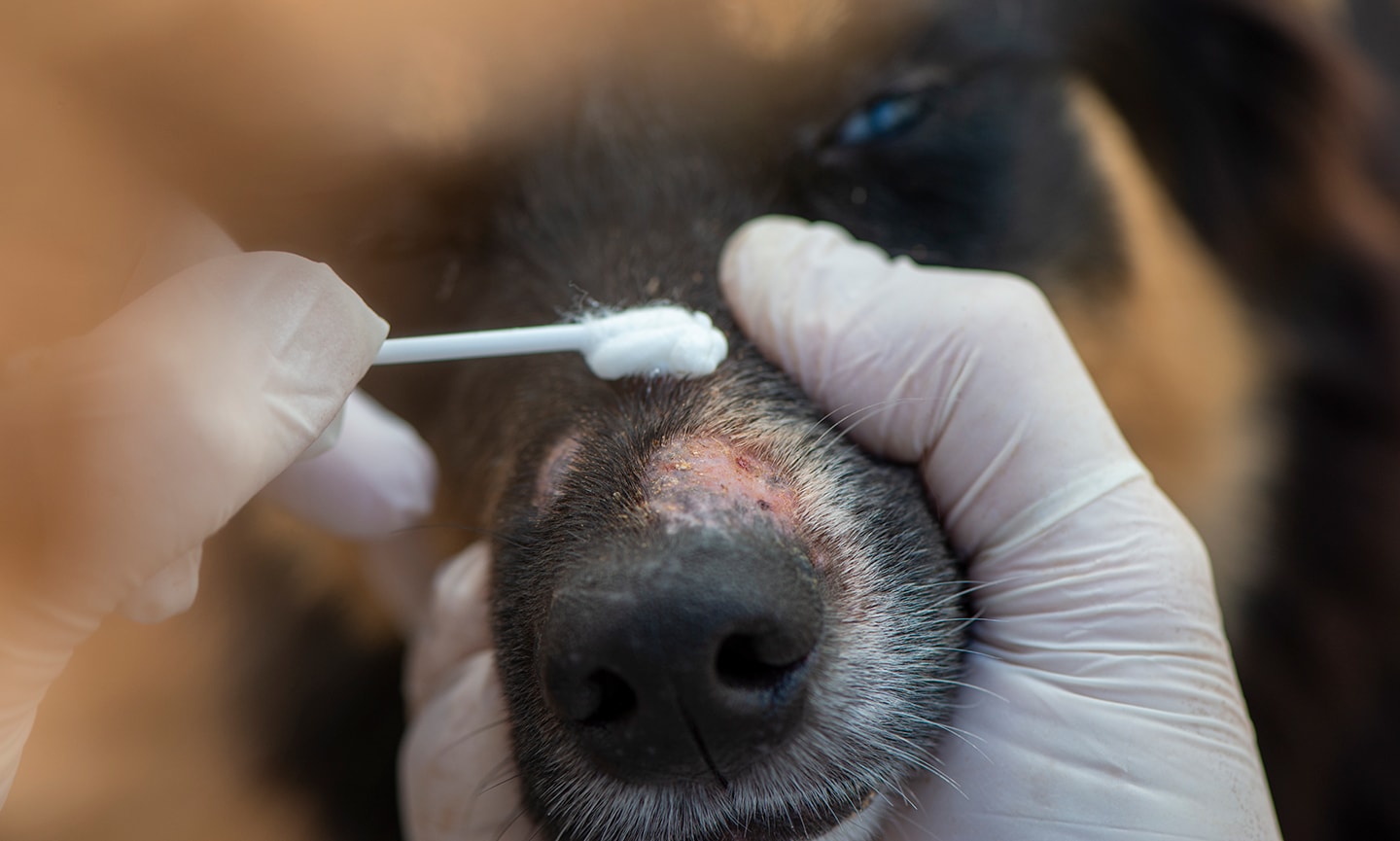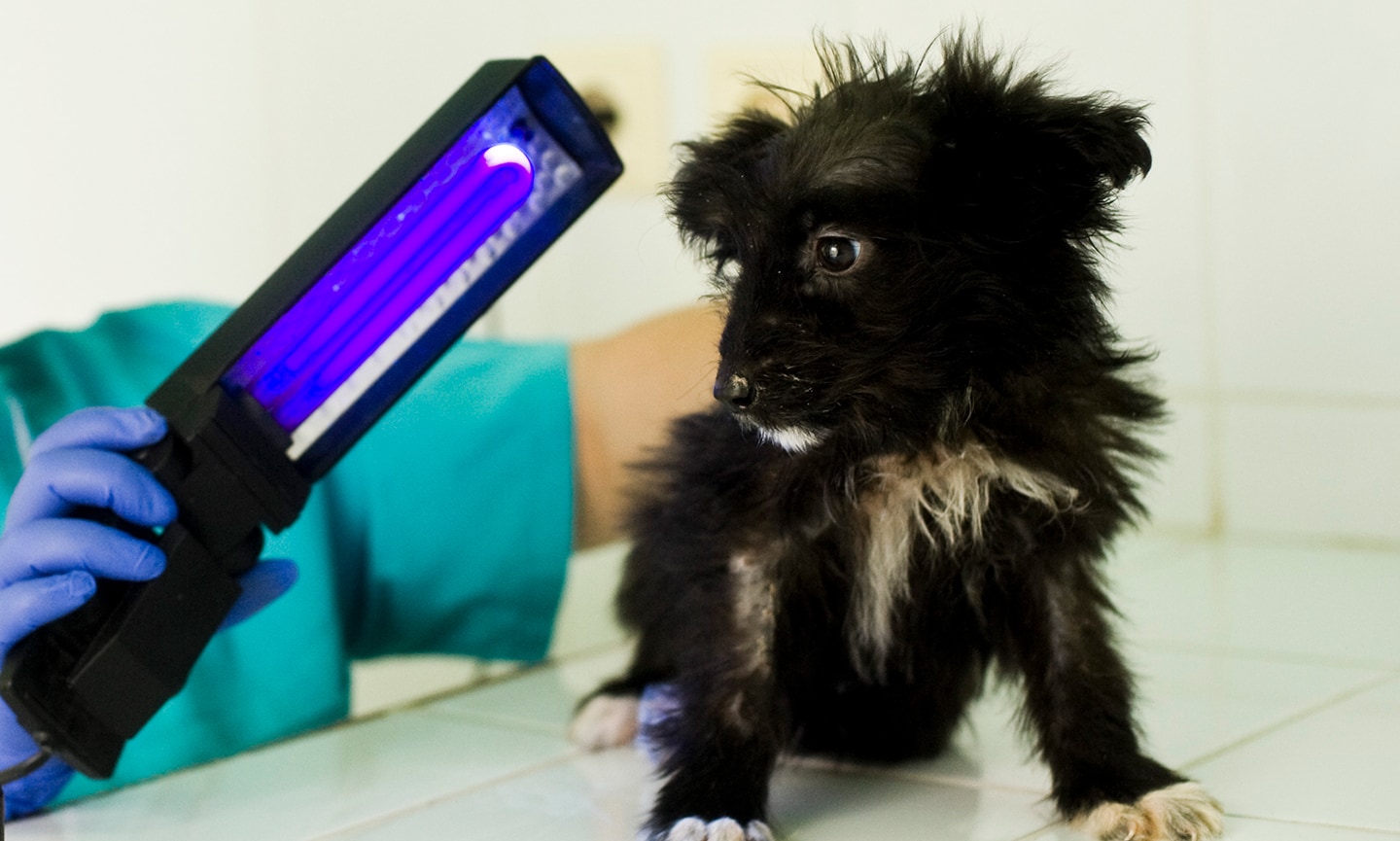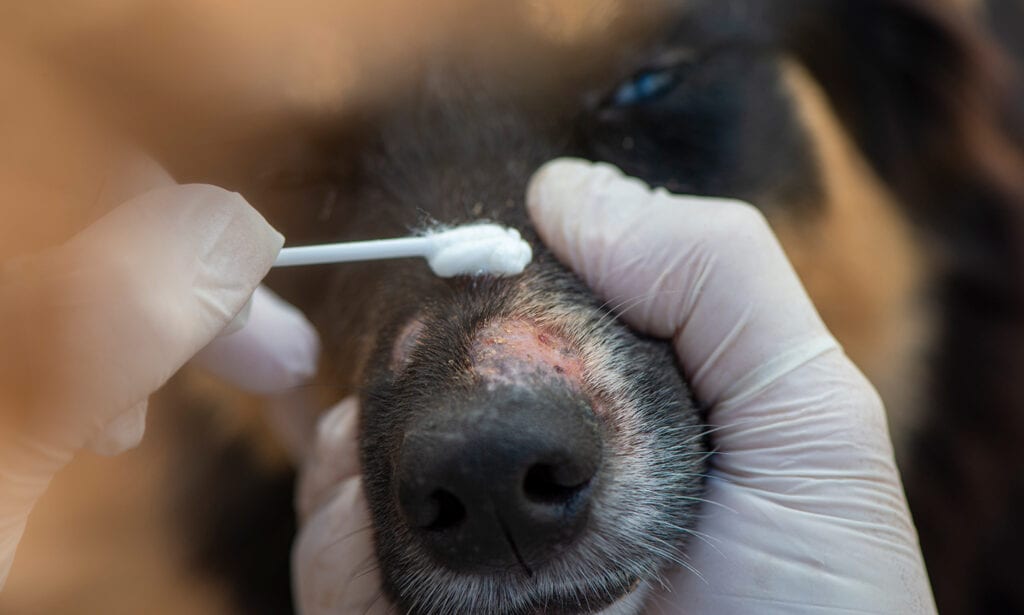Just like human kids, dogs can get all sorts of skin infections. Ringworm (not to be confused with hookworms) is one of the most common.
While ringworm doesn’t cause major harm—it’s not life-threatening and typically doesn’t progress to something more serious when treated promptly—it can be a pain to get rid of. Because it’s so contagious, ringworm can spread from dog to dog, and even to humans.
We spoke to vet experts about all things ringworm in dogs, from how to spot it to how to treat and prevent it.
In This Guide:
What Is Ringworm in Dogs?
Unlike heartworms, ringworm (which is medically referred to as dermatophytosis) isn’t actually a worm or worms; it’s a fungal infection that, in dogs, can affect the skin, hair follicles and nails. It’s caused by dermatophytes, pathogenic fungi that can be highly contagious.
Most cases of ringworm, or around 70 percent, are caused by a specific fungus named Microsporum canis, while about 20 percent are caused by Microsporum gypseum. The remaining 10 percent are caused by Trichophyton mentagrophytes.
How Do Dogs Get Ringworm?
Can a dog get ringworm from getting too close to infected dogs? The answer is yes. Dogs get ringworm through direct contact with the fungus, and getting too close to infected pets is one of the easiest ways for the infection to spread.
Dr. Andrea Johnston, DVM, a board-certified small animal veterinary internist in Lexington, Kentucky, and medical advisory board member at The Vets, says cats are often the source of ringworm in multi-pet households.
Ringworm can also be found in the environment or on objects, according to Dr. Sabrina Kong, DVM, certified canine rehabilitation practitioner at Jules Veterinary Center in Tracy, California, and veterinary contributor at WeLoveDoodles.com.
Fungal spores can remain dormant for up to 18 months, so it’s possible for your dog to contract ringworm from touching something that has ringworm spores on it that are more than a year old! Your dog can be exposed by touching the following contaminated objects:
- Combs/brushes
- Food bowls
- Bedding
- Carpet
- Furniture
- Blankets
Symptoms and Signs of Ringworm in Dogs
Ringworm symptoms in dogs can resemble other skin conditions. Because of this, it’s important to know how to identify ringworm because it’s highly contagious, while other skin diseases, such as alopecia (that is not caused by bacteria, parasites or fungus), are not.
What Does Ringworm Look like on a Dog?

In dogs, ringworm usually starts as circular areas of hair loss, or round bald spots. This is where ringworm gets its name—the main clinical sign is a “ring” of hair loss. You may see one spot or several on your dog’s skin, usually depending on when you catch it.
Dr. Johnston notes, however, that even if your dog’s hair loss doesn’t form a ring or circle, it could still be ringworm. The bald patch can take any shape.
Other possible symptoms of ringworm are:
- Scaly, scabby and/or crusty skin
- Redness
- Inflammation
- Brittle, broken hairs
- Rough, brittle claws
You may also notice your dog scratching more, although ringworm isn’t inherently itchy. Dr. Johnston says that, in some cases, opportunistic bacteria can cause a secondary skin infection, which can be very itchy.
This is one of the major things that sets ringworm apart from hot spots. When trying to identify a dog hot spot versus ringworm, consider the moisture level and itchiness. Hot spots are moist and intensely itchy, while ringworm is dry and generally non-itchy.
How Vets Diagnose Ringworm in Dogs

When you bring your dog to the vet, they’ll first do a physical exam, thoroughly inspecting your dog from head to tail, to check for ringworm lesions.
If your vet suspects ringworm, the next step will most likely be using a special ultraviolet (UV) light called a Wood’s lamp to check for signs of infection. In some ringworm infections, when this UV light hits areas that are affected with ringworm, the fungus and/or infected hair and skin will glow.
However, Dr. Johnston notes that the Wood’s lamp won’t show all types of ringworm, so a fungal culture will be used to confirm. This typically involves taking a few plucked hairs, coat brushings and/or skin cells and sending them to a lab to test them for dermatophytes.
If your vet has bigger concerns about your dog’s health, they may also recommend a blood test to look for underlying issues that may need treatment.
How To Treat Ringworm in a Dog
Ringworm treatment for dogs can take some serious time and commitment.
To start the treatment process, your vet may prescribe a medicated shampoo, oral antifungal medication or antifungal topical treatments and creams. Often, treatment involves a combination of these options to speed up recovery and reduce the number of spores in the environment.
Your vet may also recommend cutting your dog’s fur short to help the antifungal shampoo and any ointments better reach the entire skin and coat.
If your dog has a secondary bacterial infection caused by the ringworm, you’ll likely get sent home with a prescription for antibiotics, too.
Part of the treatment process also involves environmental decontamination, or making sure the fungal spores get adequately cleaned up from your home. (Remember, they can live on objects for up to 18 months.)
This means vacuuming regularly, during an active infection and beyond. You should also wash your bedding, dog beds, blankets and any other soft furnishings.
While your dog is undergoing treatment, try to keep them contained to one small space so they don’t recontaminate the areas you’re trying to clean. You’ll also have to bring any other household pets in for testing, and if any humans in your family have skin rashes, contact your doctor for advice. (Note: Athlete’s foot is a type of ringworm infection, so look for that, too.)
How To Prevent Ringworm in Dogs
Prevention is all about avoiding exposure to ringworm because it’s so contagious to animals and humans. But this doesn’t have to be a regular worry—after all, there’s only so much you can do, since you can’t see the spores in the same way you can see ticks or larger fleas.
With that said, prevention involves regular cleaning and keeping up with basic tasks. Dr. Kong has the following three tips:
- Maintain good hygiene. Vacuum and wash bedding regularly. Consider using bleach or a disinfectant, especially after an active infection.
- Groom your dog regularly. Long-haired dogs may need professional grooming every 4-6 weeks, while short-haired dogs can go 8-12 weeks; regular bathing and daily brushing are recommended in between.
- Minimize your pet’s exposure to high-risk environments. While you shouldn’t avoid socialization with other pets, try to limit time in a kennel or at crowded dog parks.
FAQs About Ringworm in Dogs
Q:
How long will my dog be contagious?
Q:
Will my dog recover from a ringworm infection?
Q:
Can a dog spread ringworm by licking?
Q:
Can other animals get ringworm?
Q:
Can humans get ringworm from dogs?
Q:
Are there home remedies to help dogs with ringworm?
More ways to protect and care for your dog's skin:
Share:









